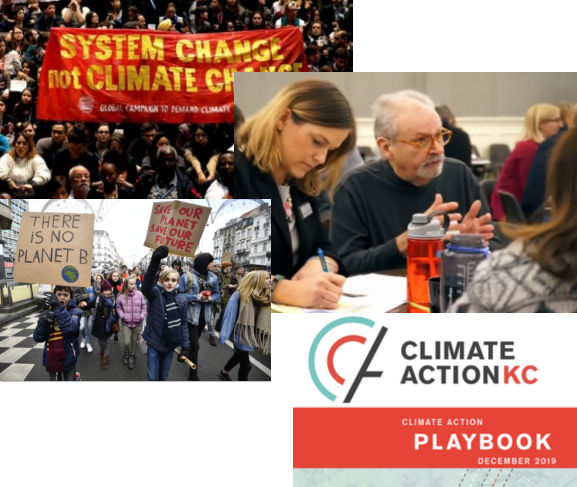
“Facilitating Climate Action at the Local Level” will be the program at this year’s annual meeting. Our keynote speaker will be Andy Rondon of Climate Action K.C.
ANNUAL MEETING OF THE SUSTAINABILITY ACTION NETWORK
Friday, 21 February 2020, 6:00pm
Douglas County Fair Grounds, Flory Building, 2120 Harper St. Lawrence KS 66046
Mr. Rondon participated in the hearings on Evergy’s rooftop solar penalty rates at the Kansas Corporation Commission, and he also helped write the Climate Action Playbook – Climate Action K.C. Playbook. Professionally, he has worked with Good Energy Solutions since 2016, a local Lawrence solar installation company – Good Energy Solutions. Prior to that, he worked in construction as a project engineer, estimator, and project manager. He has a Bachelor’s degree in Construction Engineering from Iowa State University.
The evening will begin with a pot luck dinner as in past years. The event will also include a review of our 2019 accomplishments, an open forum on projects for the current year, an introduction to our Board of Directors, and an election of new Board members. After the meeting and presentation, we’ll celebrate and socialize!
Local Solutions for Transition to a Sustainable Economy.
The Sustainability Action Network advances ecological sustainability through societal scale actions. While we work for personal lifestyle changes for individuals to minimize their carbon footprint, there is an imperative for institutional change to respond to the rapid onset of the triple global crises of Energy-Ecology-Economy. “Action” is our middle name. Visit us on the web at – Sustainability Action, and Sustainability Action | Facebook.

Ecological concerns over issues such as air quality or toxic radiation drive much progressive change, but as often as not, money prompts change. For example, early adopters installed rooftop solar mostly because it’s ecologically responsible, but it’s a dropping price point that attracts the average customer. Or, electric utilities initially installed wind generators because of lawsuits or regulations over coal pollution, but anymore, wind power is booming because its cost has dropped below that of coal.
However, as sound as this principle is, and as likely as the profit motive will bring some ecological solutions, major money players can manipulate the market to their own ends. Some examples of market distortion are: fracking operations proliferating in spite of losing money, nuclear power revival though it’s not cost-competitive with any other energy source, and corn ethanol fuel that takes as much fossil energy to make as is in the ethanol itself. Each of these can survive only because of large subsidies.
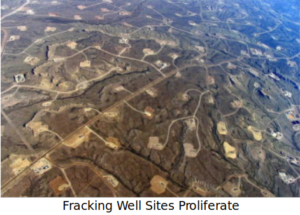
Fracking Subsidies: Fracking petroleum and natural gas is one of several “extreme energy” measures like deep sea wells, oil sands, and mountain top coal removal. All of them cost more than the old, easy, conventional fuels, but fracking costs so much more for extraction, that they actually sell the energy at a net loss. Their higher cost result from things like drilling deeper, drilling more wells that produce less energy, more complicated horizontal drilling, acquiring and disposing of process water, drilling in more remote areas, and more costly transporting the energy to markets (sometimes with disastrous consequences).
An article by Justin Mikulka in the journal “Resilience” summarized the ongoing failure of the fracking industry to make a profit. Mikulka asks “Who would be foolish enough to produce more oil than the existing infrastructure could handle?” He explains that “Frack operators across the country seem to have resisted the urge to reign in production and instead produce in excess. Unsurprisingly, this is not a recipe for profits”. But the fracking industry manipulates the numbers to appear profitable, in collusion with finance banks. Mikulka writes “It’s the Wall Street executives who are getting rich making the loans that the fracking industry struggles to repay”. It’s truly a perverse dynamic where banks could be choosing to invest in renewables, but greedily grab the gold from the option with the highest interest rates – climate-killing oil and gas – World’s Biggest Banks Are Driving Climate Change, Pumping Billions Into Extreme Fossil Fuels.
Nuclear Subsidies: Some outliers profess that nuclear electricity is carbon-free, and could be a key climate solution (ignoring the critical toxic waste costs for 10,000 years). First of all, nukes do produce CO2, from the uranium mining and milling and the immense use of concrete containment buildings. According to a report in Clean Technica, “The U.S. could achieve three times as much CO2 savings with renewables instead of nuclear, and for less money”. Nuclear makes little sense economically or environmentally. Although nuclear could replace gas and coal, we can go further faster with wind and solar.
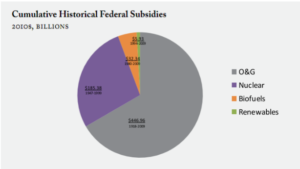
There is no rational explanation for any substantive investment in nuclear power. Utility scale solar is about the same CO2 output as nuclear, while wind is about half of either. By deploying a 50:50 mix of wind and solar instead of nuclear, there would be 150 million tons of savings of CO2 per year over nuclear. And wind and solar are a lot cheaper than nuclear. Right now unsubsidized onshore wind and solar are under $40 per MWH or 4 cents per KWH, and many places are already seeing $20 per MWH. That’s 2.5 to 7.5 times cheaper than the nuclear. Learn more at – US Could Achieve 3 Times As Much CO2 Savings With Renewables Instead Of Nuclear For Less Money.
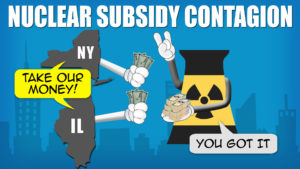
So how can there be attempts to revive nuclear energy? Through governmental subsidies in several countries including the U.S., France, England, Japan, and China. In 2017, a proposal by the Donald would have given an estimated $10.6 billion annually to nukes and coal. But when that idea crashed and burned, several states have passed bailouts, like the $300 million in Ohio, the potential billions in New York and New Jersey, and Federal low interest loans of $12 billion in Georgia to construct the over-budget Vogtle nuke. Without this “good money after bad”, nuclear energy would collapse under its own weight, leaving the money to real solutions through renewables – The Green New Deal Promises Peace and Progress. Will Nuclear Advocates Undermine it?.
Corn Ethanol Subsidies: It may have seemed apparent to members of Congress in 2005 that if a motorist pumped a gallon of fuel made from corn into their gas tank, a gallon of fossil fuel would be left in the ground. So they passed the Renewable Fuel Standard which mandates that gasoline contain a minimum of 10% ethanol. But the 1-gallon per 1-gallon ratio is a simplistic myth, and it’s now apparent that ethanol exacerbates climate disruption. Studies by the International Institute for Sustainable Development have found “that the CO2 and climate benefits from replacing petroleum fuels with biofuels like ethanol are basically zero.

Producing ethanol uses more energy than is contained in the resulting fuel, according to Cornell ecologist David Pimentel. The reason is the corn crops are grown with fossil fuel intensive machinery and inputs, to prepare the fields, plant the seed, cultivate the crop, fertilize and pesticide it with fossil fuel inputs, harvest it, dry it, and transport it to an ethanol refinery. So once again, follow the money to the bottom of this scam. Cargill and Archer Daniels Midland (ADM) are the main benefactors of increased Federal subsidies to agribusiness and tax credits to ethanol refiners – The Real Scoop on Biofuels.

BlackRock Divesting from Fossil Fuels: In contrast to such subsidized market distortions is a recent announcement by Blackrock, the world’s largest investment management corporation, with $6.96 trillion in assets under management. If the estimate is accurate that there’s about eighty trillion dollars of money on the planet, then BlackRock holds 10% in its portfolio of stocks and pension funds and the like. So there was a seismic shift felt when BlackRock acknowledge the urgency of the climate crisis, and said it will begin to start redirecting its investments. They have a considerable percent of funds in fossil fuels which have been underperforming, with some $90 billion losses to date.
Climate campaigners have been targeting BlackRock for years, and their CEO, Larry Fink, had conferred with Pope Francis who urged leading corporations to shift to renewables. But it was the $90 billion value destruction that brought BlackRock to its decision. According to a report by the Institute for Energy Economics and Financial Analysis (IEEFA), “Out of BlackRock’s $90 billion in estimated losses, 75% are due to its investments in four companies alone – ExxonMobil, Chevron, Royal Dutch Shell and BP”. Because of its sheer size, BlackRock is hugely influential in the financial sector. Kingsmill Bond, an analyst who used to work at Citibank and Deutsche Bank, “I, for one, see this as the beginning of the end for the fossil-fuel system”. Learn more at – Is BlackRock announcement “beginning of the end for fossil-fuel system?”, and Citing Climate Change, BlackRock Will Start Moving Away from Fossil Fuels.

The Amazon Rainforest is a moist broadleaf forest that covers 5.5 million square kilometers (1.4 billion acres) of the Amazon Basin which totals 7 million square kilometers (1.7 billion acres). Over half of the rainforest is located in Brazil but it is also located in other South American countries including Peru, Venezuela, Ecuador, Colombia, Guyana, Bolivia, Suriname and French Guiana. The Amazon represents over half of the planet’s rainforests, comprising the largest and most species-rich tract. It is home to half of all life on the planet.
It’s also commonly said that “the Amazon Rainforest is the lungs of the planet, producing 1/4 of Earth’s oxygen. Yes and no. Being such a huge aggregation of plants (making oxygen through photosynthesis), it does produce 20 times more oxygen than humans need. But none of the oxygen leaves the Amazon, because all the animal life there uses it among themselves. Nevertheless, the Amazon is critically instrumental in the larger process, indirectly supporting oxygen production. The process starts in Africa, in a place called the Bodélé Depression of the Sahara Desert.

10,500 years ago, a 5000 year period of monsoon rains over the Sahara Desert transformed the region into lush and habitable savanna. A number of low areas became lakes, and as with other bodies of water, there flourished an organism, four times thinner than a human hair, called a diatom, a type of phytoplankton. Each diatom lives only six days, yet they amass in vast numbers by doubling their population every 24 hours. After each boom-bust cycle, billions of dead diatoms settle to the bottom of oceans or seas, accumulating in thick layers. The key to future oxygen cycles lie in two essential minerals in the diatoms’ “skeletons” – phosphorous and iron – Saharan Dust Feeds Amazon’s Plants, and The Amazon Rainforest Gets Half Its Nutrients From a Single, Tiny Spot in the Sahara.

The Bodélé Depression in central Chad is an ancient dried up seabed, consisting of millions of tons of dead diatoms. From this site, and others in the Sahara, strong winds pick up 182 million tons of diatom dust each year and carry it across the Atlantic Ocean, where rains deposit about 72 million tons of it over the Amazon basin. The diatom-laden rain fertilizes the Amazon forest with phosphorous, replenishing the supply of this essential mineral which had leached away over the previous year. In turn, the rainforest trees transevaporate moisture from the soil up through their leaves. For example each Brazil Nut Tree, one of what are called “super trees”, lifts 260 gallons of water into the air daily – The Amazon’s Brazil nut tree creates its own rainfall — and it’s in danger. Each morning, a huge upward torrent of fog emanates from the treetops, condensing as it cools to form clouds. These rain clouds head west, encounter the Andes, and release the rain, which leaches phosphorous from the soil and carries it to the ocean to nourish the growth of diatoms.
The last stage of oxygen production is triggered by trace amounts of iron carried in the African diatom dust. Much of the deep ocean is devoid of iron, making it blue, while iron-rich coastal waters are green with biological growth. Iron is a limiting factor for plant metabolism, and diatoms need iron to photosynthesize and make oxygen. The dust from the Bodélé Depression contains iron, and only trace quantities are needed. The amount of iron needed in a ton of water would weigh about as much as a single eyelash. Between 71% and 87% of the iron in seawater samples originated in dust storms from the Sahara desert, enabling the diatoms to flourish and produce oxygen – Desert Dust Feeds Deep Ocean Life.
Unfortunately, as with other oceanic organisms, warming ocean temperatures due to climate disruption slow the growth of diatoms. The primary function of diatoms are as phytoplanktons making oxygen. Most data sources attribute 50% of the oxygen on Earth to diatoms, though some estimates are even higher. However, a study done at the University of Leicester has shown that if ocean temperatures rise around six degrees Celsius, oxygen production by phytoplankton could cease by disrupting the process of photosynthesis. The study’s lead analyst said “About two-thirds of the planet’s total atmospheric oxygen is produced by ocean phytoplankton, and therefore cessation would result in the depletion of atmospheric oxygen on a global scale. This would likely result in the mass mortality of animals and humans” – Failing phytoplankton, failing oxygen: Global warming disaster could suffocate life on planet Earth.

The Green New Deal is basically just a framework for a society to cut climate emissions by cutting fossil fuel use. Most of the details remain to be devised. The principle pillar most commonly cited is that of 100% renewable energy, but again, the type of society to be fueled by renewables is undefined. Richard Heinberg has explained that human societies “didn’t have to wait for biological evolution to slowly deliver improved organs. Cultural evolution rapidly supplied new ideas, behaviors, and tools that enabled us to take over habitat from other creatures. Starting roughly in the 19th century, concentrated energy of fossil fuels sped up cultural evolution to the point where disruptive cultural innovations . . . are spiraling entirely out of our control, notably, the planetary feedbacks associated with climate change”. – Power, the Acceleration of Cultural Evolution, and Our Best Hope for Survival. It’s not just the type of energy use that must change, but the quantity and pace of energy use.
Award winning ecological and energy journalist, Andrew Nikifaruk, has written “We have a ways to go if we choose to reduce emissions by simply replacing fossil fuels with wind turbines. What also matters is using less energy. We have to look at downsizing, degrowth, using less”. Those are critical considerations for crafting a successful Green New Deal. It’s not easy to grasp the kind of energy transition that must take place by comparing the various percentages of renewables growth and ratios of fossil vs. renewable use rates. But consider how Tad Patzek, a professor of petroleum and chemical engineering in Texas, puts it. “If we divide the days of the year up based on total energy use, fossil fuels — oil, coal and natural gas — powered the globe for 321 days in 2018. Dams and nuclear power kept the lights on for 15 days. Renewables energized the globe for only about 29 days, and most of that energy came from biomass or wood burning.”

Roger Pielke Jr., a Colorado professor, recently noted “If we really wanted to reach zero carbon emissions by 2050, and we solely choose wind power as the solution, we’d need to build and deploy 1,500 wind turbines on about 300 square miles every day for the next 30 years”. That’s impossible, if for no other reason than the amount of fossil fuel needed to build them. But it illustrates the magnitude of society’s challenge. The math doesn’t work to simply keep the party going with renewables. Globally, electrical demand has been rising faster than the increase in production from renewables for decades, with little or no change. David Hughes, one of Canada’s most esteemed energy analysts, pointed out that “We need to radically reduce energy consumption and use renewables to actually retire fossil fuel infrastructure”. To date, the evidence shows that we have largely used renewables to consume more energy – It Bears Repeating: Renewables Alone Won’t End the Climate Crisis.
Nate Hagens, a former Wall Street wolf and now an adjunct professor at the University of Minnesota, emphasizes that our current energy glut lifestyle and the Green New Deal both suffer from the same shortcomings. Neither understand that it’s energy flows which underpin economic flows and growth. Longtime energy analyst, Andrew Nikifaruk explains, “The fossil fueled business-as-usual model pretends that expensive fossil fuels like fracked oil or bitumen can replace cheap conventional stuff with no global economic contraction. They can’t. The Green New Deal model pretends that renewables can provide the same quality and quantity of energy as fossil fuels with no global upheaval. They can’t. Both ignore the limits imposed when 7.7 billion human beings are consuming the planet, and the dire consequences of that for biodiversity. Any way you look at it, overpopulation is part of the problem.”

Hagens thinks the world needs a non-partisan conversation about this reality, and about how to prepare for a 30-per-cent drop in energy consumption. He says civilization has three options: it can muddle on, bend, or break. Muddling is what we are doing now. So far, no one is talking about bending. That would require dramatic reductions in energy spending and a different way of living. But that’s the keystone to a realistic, though extremely difficult, Green New Deal – The Green New Deal Battles Business as Usual. Both Will Doom Us.
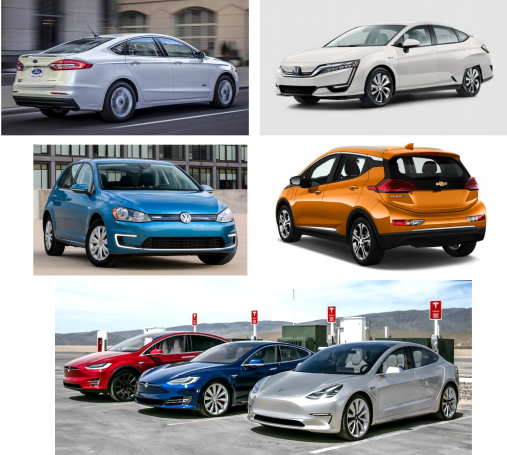
Saturday, 14 September 2019, 10:00am-2:00pm – FREE.
RAIN DAY: Sunday, 15 September 2019, 10:00am-2:00pm
Hy-Vee Grocery, 3504 Clinton Prkw., Lawrence KS 66047
The second annual Lawrence Electric Vehicle Showcase is being organized by the Sustainability Action Network with the help of our co-sponsor, The Sierra Club/Wakarusa Group. There will be at least 21 cars on display by their owners, including Nissan LEAF, Tesla Model S, Model 3, and Model X, Toyota Prius Prime, Chevy Bolt and Chevy Volt, and Ford C-MAX Energi. You can talk with EV owners about the advantages of driving an EV. Here’s an EV guide showing the range and price of each vehicle – EV Guide_June 2019.
Electric vehicles are smooth and quiet, with high torque and instant acceleration. Driving on electricity is about five times cheaper than fueling with gasoline, and maintenance is cheaper too. Because they get 100mpg equivalent or better, EVs are one the most effective ways that motor vehicles can reduce petroleum use and cut air pollution. When charged by renewable energy, EVs are zero emissions. Because they are so much more efficient than gasoline cars, EVs charged from a utility produce fewer emissions than internal combustion vehicles.

We’ll have electric bicycles too, and electric scooters. Electric cars are a great improvement over fossil cars, but E-bicycles are the gold standard, using but a fraction of a percent of energy used by a motor vehicle. A 4000lb electric car requires up to 60 Kilowatts (60,000 Watts) of electricity per hour, and consumes about ten times the electricity used by a home. Pedaling a standard bicycle uses only 150 Watts to go 20mph, and slightly more if electric pedal assisted. More info is available at – Lawrence Electric Vehicle Showcase.

In addition to the local sponsors, national sponsors are Nissan LEAF, Plug In America, the national Sierra Club, and the Electric Auto Association.


















Recent Comments